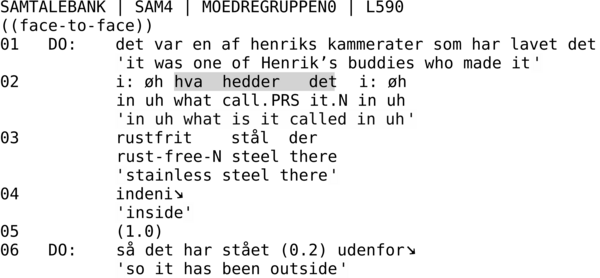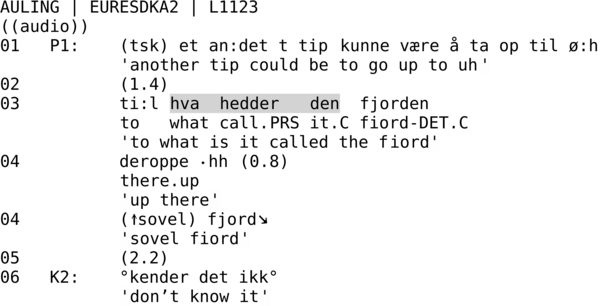Hva hedder det as a word search marker
The expression hva hedder det ’what is it called’ (and variations thereof such as hva det hedder ’what it’s called’, and hva er det det hedder ’what is it it’s called’) seem to have three main functions: word search, topic change, and to signal reservation due to reflection. This entry is about its function as a word search marker.
Hva hedder det can, alongside with hesitation markers such as øh, pauses, vowel lengthening or repetitions of the previous word, signal that the speaker can’t find the right word or wording and is searching for it. Word search is a kind of self-initiated repair, that is, the speaker has located a problem in their own speech which can be repaired. The one repairing can either be the speaker (self-repair) or another conversation participant (other repair). Most often, hva hedder det is not responded to by other speakers, and often leads to self-repair.
There is a difference between specific and non-specific word search. In non-specific word searches, the placement of the word search marker hva hedder det doesn’t specify what kind of information the speaker is looking for. The word search in such cases is ’open’, and the other speakers thus have no real chance of answering or suggesting a guess as to what the speaker might be searching for. This can be seen in the example below, where three people are talking about a workplace suffering from many absences due to sickness:
![AULING | GENBRUGSSAMLET2 | L1111 ((face-to-face)) 01 B: men >nu har de< oss ↓ø:hm 'but not they have also uhm' 02 (1.0) 03 B: hvis det e:*r* if it.N is.PRS 'if it is' >hva er'et det hedder<→ what be.PRS-it.N it.N call.PRS 'what is it it is called' 05 (0.6) 06 B: mangl(er) personale ikke↗ 'lacks staff, right' 07 B: ·h[hhh å somme]tider tager nogen ind→ 'and sometimes takes somebody in' 08 ?: [·hja ] 'yes' 09 (0.7) 10 B: bistandsklienter ind å det skal hjælpe→ 'benefit claimants in and and that should help' 11 ((B lifts hand up and down in lines 3)) 12 (0.8) 13 B: å det e:r ikk altid→ 'and it’s not always' 14 (0.6) 15 A: °nej°= 'no' 16 B: =lige heldigt↘ 'so fortunate' 17 A: °nej°↘ 'no'](/fileadmin/_processed_/e/3/csm_hva_hedder_det_as_a_word_search_marker_1_041239bf79.png)
In line 1, B begins an utterance which is cut short by an øhm (‘uhm’) and then the expression hva er’et det hedder (‘what is it it is called’). These word search markers occur before it is clear what the utterance is even about: a question, statement, or something else.
On the other hand, in a specific word search the word search marker is placed later in the utterance, where there is a limit to what might come next, perhaps because there can only be a certain word class in that position. In the example below we see hva hedder det occurring after the preposition i (‘in’) which should be followed by a noun phrase.

As mentioned, hva hedder det is usually not responded to by others but is followed by the same speaker finding the missing word or wording. This, among other things, is due to the fact that there is a preference for self-repair in spoken language. Clausen and Pedersen (2017) investigated which factors play a role in whether hva hedder det is responded to with other repair. They found that neither declarative vs interrogative forms (hva hedder det (’what is it called’) vs. hva det hedder (‘what it is called’)); how fast the utterance is spoken, nor utterance volume play a role. Instead, what might play a role is the speaker’s gaze direction at the time of uttering hva hedder det: if the speaker keeps their gaze where it was already, (at the recipient or somewhere else), the tendency was for the recipient to respond. However, if the speaker changes the direction of the gaze, perhaps even closes their eyes, or shakes their head, the tendency was for the recipient to respond. Gaze direction alone, however, can’t be the only deciding factor influencing whether there is a response, because hva hedder det also occurs in telephone conversations.
Another factor which can increase the likelihood of getting a response is using a more elaborate format of the expression, which provides more information about what the speaker is searching for. This can be seen below:

P uses the format hva hedder den fjorden deroppe (’what’s it called the fiord up there’) to which after a pause K answers kender det ikk (‘don’t know it’).
Altogether, it appears that the typical situations are those in which hva hedder det
Sources and further reading
Bavelas, Coates and Johnson (2002) describe the different factors at play in when an utterance is responded to, i.a., gaze direction.
Clausen and Pedersen (2017) is a thorough review of hva hedder det.
Goodwin and Goodwin (1986) is an article about word search and responses to them.
